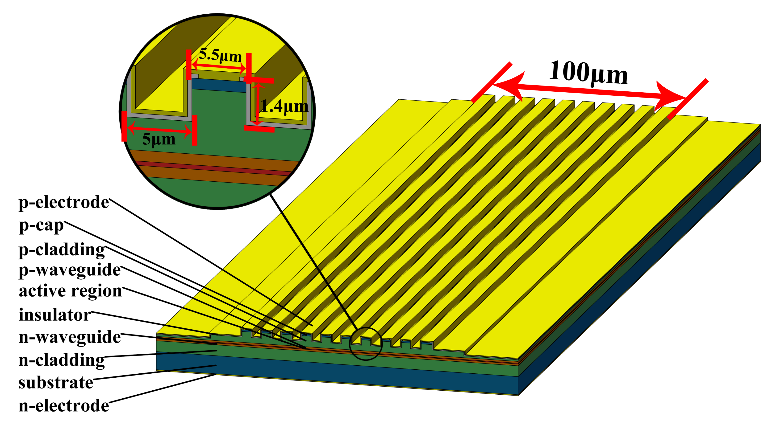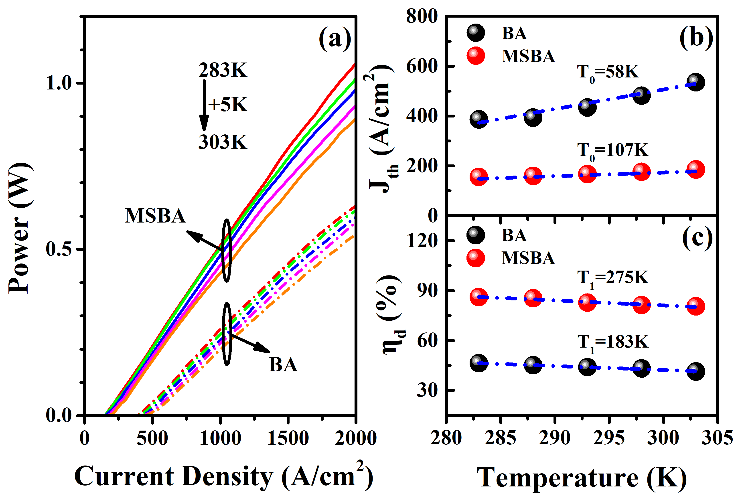Breakthrough progress in the research of high-power semiconductor lasers from the Changchun Optical Machine
[ China Instrument Network Instrument Development ] The germanide semiconductor laser can realize the mid-infrared laser output of 1.8μm-4μm, which has the advantages of small size, high efficiency, and direct drive of electric drive. It is a hot research topic in the field of mid-infrared laser technology. Infrared photoelectric technology, chemical gas and dangerous goods monitoring and other fields have important application prospects, and can be used as a seed source and a similar pumping source for mid-infrared fiber lasers. However, due to the lower thermal conductivity and high hole mobility of the germanide semiconductor material, lateral carrier leakage causes the germanide semiconductor laser to be inefficient, poor in beam quality, and poor in temperature stability.

Figure 1. Schematic diagram of a germanide microridge wide area (MSBA) waveguide laser

Figure 2. Micro-ridge waveguide improves the power, threshold, and efficiency temperature stability of a germanide semiconductor laser.
Recently, the team of researcher and staff of Changchun Institute of Optics and Mechanics collaborated with the team of researchers from the Institute of Semiconductors of the Chinese Academy of Sciences, Niu Zhichuan, to propose a waveguide structure with a broad ridged micro-ridge, which effectively suppressed the lateral leakage and accumulation of carriers, which would be 1.96? The maximum energy conversion efficiency of the m-wavelength telluride laser is increased from 9.8% to 30.5%, the continuous output power exceeds 1.28W, the lateral beam quality is improved by 36%, and the effects of threshold, temperature characteristics and current on the far field are significantly improved. This study provides a viable technical solution for the implementation of high-brightness germanide semiconductor lasers. The results were published in Applied Physics Express, 11, 032702 (2018), and selected by Advances in Engineering of Canada as an innovative and important area of ​​engineering progress. Scientific paper (Key Scientific Article), and special reports.
Advances in Engineering (AIE) is a Canadian science and technology organization established in 2005 to rapidly and rapidly disseminate important scientific achievements and innovative technologies in the engineering field that benefit humanity on a global scale. Its main readers and audiences have been Well-educated engineering and physics scientists, professors and students. AIE is highly screened by the international expert advisory group every week, and selects less than 20 excellent papers from the literature published in the global engineering field for special reports, including materials engineering, chemical engineering, electronic engineering, mechanical engineering, nanotechnology, Civil engineering and general engineering, selected papers need to be of special scientific importance and can be understood by a wide range of scientific readers, with a selection rate of less than one in a thousand. In addition to the attention of major research institutions around the world, AIE is also linked by the top 50 engineering companies in the world to track breakthrough technological advances.
The work was funded by the National Natural Science Foundation of China's major project “Basic Theory and Key Technologies of Medium-Infrared Lasers for Telluride Low-Dimensional Structuresâ€.
(Original title: Breakthrough progress in the research of high-power semiconductor lasers for telluride in Changchun Optical Machine)
